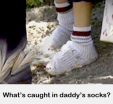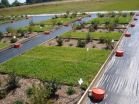CARMEL, CA, June 24, 2011 (Press-News.org) Suburban Hobby Farmer asked us what was the most important lesson children have learned in a garden in my classes. My answer comes from our walks through the forest, an empty lot, a patch of earth on a farm, a small tract of woodland while wearing a pair of Daddy's socks. At the end of these walks the children plant the socks into a flat full of potting soil and a magic journey full of promise and faith begins. From here on out every child who plants their daddy's socks after walking through a forest with the socks over their tennis shoes is intimately connected to any biology lesson you could give via flower anatomy, any literature lesson you could expose a child to via the mysteries in nature or the forces of good and evil, any mathematics lesson via handfuls of seeds, any green living ideas you may come up with via composting and fertilizing. All lessons in all areas of inquiry are squeezed or stuck into the fabric of a size 12 pair of socks.
As the children watch their gardens sprout out of their daddy's socks they begin to navigate a course between their own intimate connection to the new plants and the more general happenings with living things in a garden. This connection between intimacy and the more general events with living things leads to a very high degree of sustainability of "Daddy's sock garden". In fact, this high degree of sustainability can't be found in any other garden that doesn't germinate out of such an intimate thing as a pair of Daddy's socks.
It's this bottom-up investment the child is making that guarantees many generations of plants to be successful, season after season after season. The children care for each and every plant that germinates out of Daddy's socks; watch it like they watch the stars, water it as if they could hear the plant asking for water, feed it as if they just knew it was hungry, wipe off any beetles, aphids, white flies from the leaves as if they could hear the plant screaming for relief from the bites, the choked off apical buds, the voracious eating of larvae on the underside of its leaves. If they take their daddy's socks home with them or to their grandparents home and plant the socks there, the degree of sustainability of their garden is even greater than if they did not remove the socks from our garden in our lesson area. Some children even call their grandparents and agree on a delivery date for the socks to arrive. This may be only 50 miles away or 1000 miles away. We're talking Daddy's socks here!
Through the years of teaching, I have learned that this magic journey full of promise and faith is greater than any globe's circumference, any planet's orbit. It goes on and on and on. Having Daddy involved in a child's garden from the very beginning gives a child a strong sense of belonging, a well grounded sense of leadership, and a genuine sense of community. If you and a child are fortunate enough to plant a garden with his daddy's socks you will find that the questions the child asks are far more important than the answers that you have. Daddy's socks seem to bring out the soul of the child.
StarChild Science's website has recently expanded five times overnight with timely science education articles. This innovative science site provides hands-on science experiences for children and teachers that will change the way our children perceive their future.
Website: http://www.starchildscience.org
StarChild Science: Planting Daddy's Socks
Making a commitment to a garden is easy for a child once Daddy gets involved. His sense of belonging, his leadership and and his sense of community seems to bring out the soul of the child.
2011-06-24
ELSE PRESS RELEASES FROM THIS DATE:
Hereditary colon cancer syndrome marked by abnormally dense blood vessel growth in mouth
2011-06-24
A team led by Johns Hopkins researchers has found that a hereditary colon cancer syndrome, familial adenomatous polyposis (FAP), is associated with abnormally dense blood vessel growth in the skin lining the mouth.
The finding, reported in the June issue of Familial Cancer, could lead to a quick screening test for FAP, which is normally diagnosed with expensive DNA tests and colonoscopies, and sometimes goes unnoticed until cancer develops.
"This higher blood vessel density in the mouth may reflect an abnormal state of cells lining the digestive tract – including the ...
Slow growth of childhood brain tumors linked to genetic process seen in skin moles
2011-06-24
Johns Hopkins researchers have found a likely explanation for the slow growth of the most common childhood brain tumor, pilocytic astrocytoma. Using tests on a new cell-based model of the tumor, they concluded that the initial process of tumor formation switches on a growth-braking tumor-suppressor gene, in a process similar to that seen in skin moles.
The findings, published in the June 1 issue of Clinical Cancer Research, could lead to better ways of evaluating and treating pilocytic astrocytomas.
"These tumors are slow-growing to start with, and sometimes stop growing, ...
Study of phytoremediation benefits of 86 indoor plants published
2011-06-24
SUWON, KOREA—Formaldehyde is a major contaminant of indoor air, originating from particle board, carpet, window coverings, paper products, tobacco smoke, and other sources. Indoor volatile organic compounds (VOCs) such as formaldehyde can contribute to allergies, asthma, headaches, and a condition known as ''sick building syndrome". The concern is widespread; a 2002 report from the World Health Organization estimated that undesirable indoor volatiles represent a serious health problem that is responsible for more than 1.6 million deaths per year and 2.7% of the global burden ...
AGU journal highlights -- June 23, 2011
2011-06-24
The following highlights summarize research papers that have been recently published in Geophysical Research Letters (GRL); Geochemistry, Geophysics, Geosystems (G-Cubed); and Paleoceanography (PA).
In this release:
Estimating climate effects of contrails
Did Aboriginal forest burning affect Australian summer monsoon?
Determining the trigger of East Asian dust storms
El Niño–Southern Oscillation variability persisted in warmer world
Constraining the trigger for ancient warming episode
Next generation atmospheric model improves hurricane forecasting
Theorized magnetic ...
New and old threats to soybean production
2011-06-24
University of Illinois researchers identified the top pathogens, pests and weeds affecting soybean production in a recent article in Food Security. Soybean aphid, soybean rust, soybean cyst nematode, Sclerotina stem rot and the exotic pathogen, red leaf blotch, were featured as some of the top biotic constraints that may affect soybean production now and in the future.
"Enormous potential exists to increase future soybean production," said Glen Hartman, U of I professor of crop sciences and USDA-ARS research scientist. "Genetic resources, used through both traditional ...
Landscape coefficients prove useful for urban water conservation efforts
2011-06-24
COLLEGE STATION, TX—Although water consumption and conservation are widely recognized as significant environmental concerns in the United States, most Americans are still unaware of the major impact of landscape irrigation on their regional water supplies. One startling example: a 2004 study of homeowners in College Station, Texas, estimated that more than 24 to 34 million gallons of excess water were used annually for landscape irrigation alone.
According to the authors of a study published in HortScience, end-users lack understanding of best management practices for ...
A step toward controlling Huntington's disease?
2011-06-24
Johns Hopkins researchers have identified a natural mechanism that might one day be used to block the expression of the mutated gene known to cause Huntington's disease. Their experiments offer not an immediate cure, but a potential new approach to stopping or even preventing the development of this relentless neurodegenerative disorder.
Huntington's disease is a rare, fatal disorder caused by a mutation in a single gene and marked by progressive brain damage. Symptoms, which typically first appear in midlife, include jerky twitch-like movements, coordination troubles, ...
Service projects increase learning, social impact for undergrads
2011-06-24
COLLEGE STATION, TX—Service learning involves the incorporation of community service into a course as a requirement for credit or graduation. In the service learning model, students participate in ''real life'' and hands-on activities while also working within the community. Researchers T.M. Waliczek and J.M. Zajicek reported on a study of service learning integrated into a university-level horticulture course in HortTechnology. The team found that involvement in service learning changed students' opinions regarding community involvement and also increased their understanding ...
To fix diabetic nerve damage, blood vessels and support cells may be the real targets of treatment
2011-06-24
Blood vessels and supporting cells appear to be pivotal partners in repairing nerves ravaged by diabetic neuropathy, and nurturing their partnership with nerve cells might make the difference between success and failure in experimental efforts to regrow damaged nerves, Johns Hopkins researchers report in a new study.
About 20 percent of diabetics experience neuropathy, a painful tingling, burning or numbness in the hands and feet that reflects damage to nerves and sometimes leads to infections and amputation of the toes, fingers, hands and feet over time. Current treatments ...
Dairy manure goes urban
2011-06-24
WIMAUMA, FL—When natural ecosystems are replaced by roads, homes, and commercial structures, soil is negatively impacted. Studies have shown that, among other issues, distressed urban soils are often significantly compacted, may have alkaline pH, and may contain low amounts of essential organic matter and nutrients. This altered soil is typically not conducive to healthy plant root growth and establishment, leading to challenges for urban landscapes and home gardens.
"The management of urban soils often requires a different approach than is applied to natural or agricultural ...
LAST 30 PRESS RELEASES:
Strengthened immune defense against cancer
Engineering the development of the pancreas
The Journal of Nuclear Medicine ahead-of-print tip sheet: Jan. 9, 2026
Mount Sinai researchers help create largest immune cell atlas of bone marrow in multiple myeloma patients
Why it is so hard to get started on an unpleasant task: Scientists identify a “motivation brake”
Body composition changes after bariatric surgery or treatment with GLP-1 receptor agonists
Targeted regulation of abortion providers laws and pregnancies conceived through fertility treatment
Press registration is now open for the 2026 ACMG Annual Clinical Genetics Meeting
Understanding sex-based differences and the role of bone morphogenetic protein signaling in Alzheimer’s disease
Breakthrough in thin-film electrolytes pushes solid oxide fuel cells forward
Clues from the past reveal the West Antarctic Ice Sheet’s vulnerability to warming
Collaborative study uncovers unknown causes of blindness
Inflammatory immune cells predict survival, relapse in multiple myeloma
New test shows which antibiotics actually work
Most Alzheimer’s cases linked to variants in a single gene
Finding the genome's blind spot
The secret room a giant virus creates inside its host amoeba
World’s vast plant knowledge not being fully exploited to tackle biodiversity and climate challenges, warn researchers
New study explains the link between long-term diabetes and vascular damage
Ocean temperatures reached another record high in 2025
Dynamically reconfigurable topological routing in nonlinear photonic systems
Crystallographic engineering enables fast low‑temperature ion transport of TiNb2O7 for cold‑region lithium‑ion batteries
Ultrafast sulfur redox dynamics enabled by a PPy@N‑TiO2 Z‑scheme heterojunction photoelectrode for photo‑assisted lithium–sulfur batteries
Optimized biochar use could cut China’s cropland nitrous oxide emissions by up to half
Neural progesterone receptors link ovulation and sexual receptivity in medaka
A new Japanese study investigates how tariff policies influence long-run economic growth
Mental trauma succeeds 1 in 7 dog related injuries, claims data suggest
Breastfeeding may lower mums’ later life depression/anxiety risks for up to 10 years after pregnancy
Study finds more than a quarter of adults worldwide could benefit from GLP-1 medications for weight loss
Hobbies don’t just improve personal lives, they can boost workplace creativity too
[Press-News.org] StarChild Science: Planting Daddy's SocksMaking a commitment to a garden is easy for a child once Daddy gets involved. His sense of belonging, his leadership and and his sense of community seems to bring out the soul of the child.

